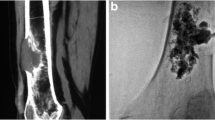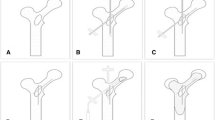Abstract
Objective
To review our 10-year experience with percutaneous long bone cementoplasty (PLBC) in poor surgical patients.
Materials and methods
Fifty-one patients were included. Primary endpoints were pain and functional outcomes one month following PLBC. A secondary endpoint dealt with factors predicting cement leakage. Delayed adverse events and overall survival (OS) were also investigated.
Results
Sixty-six lesions were treated. Local pain relief at 1-month occurred in 59/66 lesions (89.4 %); pain improvement was significantly more common for lesions of the upper limb (p < 0.05). Limb functionality at one month improved in 46/64 lesions (71.8 %); lesions ≤ 3 cm showed better outcomes in terms of limb function (p <0.05). Cement leakage was minor and asymptomatic in 26 cases (26/66, 39.4 %); in one case (1/66, 1.5 %) symptomatic minor amount of intra-articular cement leakage occurred. Factors predicting cement leakage were diaphyseal location of the lesions, cortical bone disruption and extra-bone tumour extension (p < 0.05). The most common delayed adverse event was fracture (6/66, 9.1 %). OS at 1-, 2- and 3-years was 61.2 %, 30.9 % and 23.0 %, respectively.
Conclusions
For poor surgical candidates, at 1-month follow-up, PLBC proved to be safe and effective. If stress fracture occurs following PLBC, surgical external fixation is still an affordable therapeutic option.
Key Points
• Percutaneous long bone cementoplasty may be proposed to poor surgical patients
• Pain palliation is more significant for lesions of the upper limb
• Limb function improves significantly for lesions sized ≤ 3 cm
• Fracture is the most common delayed adverse event (9 % of cases)
• If cement stress fracture occurs, surgical external fixation is still feasible



Similar content being viewed by others
Abbreviations
- PMMA:
-
Polymethylmethacrylate
- PLBC:
-
Percutaneous long bone cementoplasty
- CBCT:
-
C-arm Cone Bean CT
- mTFE:
-
Mean time to the first delayed adverse event
- NS:
-
Non-significant
References
Oster G, Lamerato L (2013) Natural history of skeletal-related events in patients with breast, lung, or prostate cancer and metastases to bone: a 15-year study in two large US health systems. Support Care Cancer 21(12):3279–3286
Anselmetti GC (2010) Osteoplasty: percutaneous bone cement injection beyond the spine. Semin Interv Radiol 27(2):199–208
Chow E, Harris K (2007) Palliative radiotherapy trials for bone metastases: a systematic review. J Clin Oncol 25(11):1423–1436
Ross JR, Saunders Y (2003) Systematic review of role of bisphosphonates on skeletal morbidity in metastatic cancer. BMJ 327(7413):469
Gangi A, Buy X (2010) Percutaneous bone tumor management. Semin Interv Radiol 27(2):124–136
Gangi A, Tsoumakidou G (2010) Quality improvement guidelines for bone tumour management. Cardiovasc Intervent Radiol 33(4):706–713
Coleman RE (2006) Clinical features of metastatic bone disease and risk of skeletal morbidity. Clin Cancer Res 12:6243s–6249s
Heini PF, Franz T (2004) Femoroplasty-augmentation of mechanical properties in the osteoporotic proximal femur: a biomechanical investigation of PMMA reinforcement in cadaver bones. Clin Biomech (Bristol, Avon) 19:506–512
Sutter EG, Mears SC (2010) A biomechanical evaluation of femoroplasty under simulated fall conditions. J Orthop Trauma 24(2):95–99
Masala S, Mastrangeli R (2009) Percutaneous vertebroplasty in 1,253 levels: results and long-term effectiveness in a single centre. Eur Radiol 19(1):165–171
Tong FC, Cloft HJ (2000) Transoral approach to cervical vertebroplasty for multiple myeloma. Am J Roentgenol 175(5):1322–1324
Basile A, Giuliano G (2008) Cementoplasty in the management of painful extraspinal bone metastases: our experience. Radiol Med 113:1018–1028
Anselmetti GC, Manca A (2008) Treatment of extraspinal painful bone metastases with percutaneous cementoplasty: a prospective study of 50 patients. Cardiovasc Intervent Radiol 31(6):1165–1173
Masala S, Volpi T (2011) Percutaneus osteoplasty in the treatment of extraspinal painful multiple myeloma lesions. Support Care Cancer 19(7):957–962
Iannessi A, Amoretti N (2012) Percutaneous cementoplasty for the treatment of extraspinal painful bone lesion, a prospective study. Diagn Interv Imaging 93(11):859–870
Sun G, Jin P (2014) Cementoplasty for managing painful bone metastases outside the spine. Eur Radiol 24(3):731–737
Sarahrudi K, Hora K (2006) Treatment results of pathological fractures of the long bones: a retrospective analysis of 88 patients. Int Orthop 30(6):519–524
Dijstra S, Wiggers T (1994) Impending and actual pathological fractures in patients with bone metastases of the long bones. A retrospective study of 233 surgically treated fractures. Eur J Surg 160(10):535–542
Weiss RJ, Wedin R (2011) Surgery for skeletal metastases in lung cancer. Acta Orthop 82(1):96–101
Wedin R (2001) Surgical treatment for pathologic fracture. Acta Orthop Scand Suppl 72(302):1–29
Mirels H (1989) Metastatic disease in long bones. A proposed scoring system for diagnosing impending pathologic fractures. Clin Orthop Relat Res 249:256–264
Dean JR, Ison KT (2000) The strengthening effect of percutaneous vertebroplasty. Clin Radiol 55:471–476
Deramond H, Wright NT (1999) Temperature elevation caused by bone cement polymerization during vertebroplasty. Bone 25(2):17S–21S
Saad F, Lipton A (2007) Pathologic fractures correlate with reduced survival in patients with malignant bone disease. Cancer 110(8):1860–1867
Ravaud JF, Delcey M (1999) Construct validity of the functional independence measure (FIM): questioning the unidimensionality of the scale and the “value” of FIM scores. Scand J Rehabil Med 31:31–41
Nussbaum DA, Gailloud P (2004) A review of complications associated with vertebroplasty and kyphoplasty as reported to the Food and Drug Administration medical device related web site. J Vasc Interv Radiol 15:1185–1192
Leclair A, Gangi A (2000) Rapid chondrolysis after an intra-articular leak of bone cement in treatment of a benign acetabular subchondral cyst: an unusual complication of percutaneous injection of acrylic cement. Skelet Radiol 29(5):275–278
Tuncali K, Morrison PR (2007) MRI-guided percutaneous cryotherapy for soft-tissue and bone metastases: initial experience. Am J Roentgenol 189(1):232–239
Dierselhuis EF, Jutte PC (2010) Hip fracture after radiofrequency ablation therapy for bone tumors: two case reports. Skelet Radiol 39(11):1139–1143
Deschamps F, Farouil G (2012) Percutaneous stabilization of impending pathological fracture of the proximal femur. Cardiovasc Intervent Radiol 35(6):1428–1432
Tsoumakidou G, Borensztein M (2013) Postablation insufficiency fracture of the iliac crest: management by percutaneous screw fixation. Cardiovasc Intervent Radiol. doi:10.1007/s00270-013-0781-1
Acknowledgments
All the authors would like to thank sincerely Emiliano Schena, PhD for his kind statistical advice and Jones Iriondo for her kind assistance with paper drafting.
The scientific guarantor of this publication is Dr. Jean Palussiere, MD, Chief of the Department of Radiology, Institut Bergonié, Bordeaux, France. The authors of this manuscript declare no relationships with any companies, whose products or services may be related to the subject matter of the article. The authors state that this work has not received any funding. Institutional Review Board approval was obtained. Written informed consent was waived by the Institutional Review Board.
Methodology: Retrospective, Observational, Performed at one institution.
Author information
Authors and Affiliations
Corresponding author
Rights and permissions
About this article
Cite this article
Cazzato, R.L., Buy, X., Eker, O. et al. Percutaneous long bone cementoplasty of the limbs: experience with fifty-one non-surgical patients. Eur Radiol 24, 3059–3068 (2014). https://doi.org/10.1007/s00330-014-3357-9
Received:
Revised:
Accepted:
Published:
Issue Date:
DOI: https://doi.org/10.1007/s00330-014-3357-9




